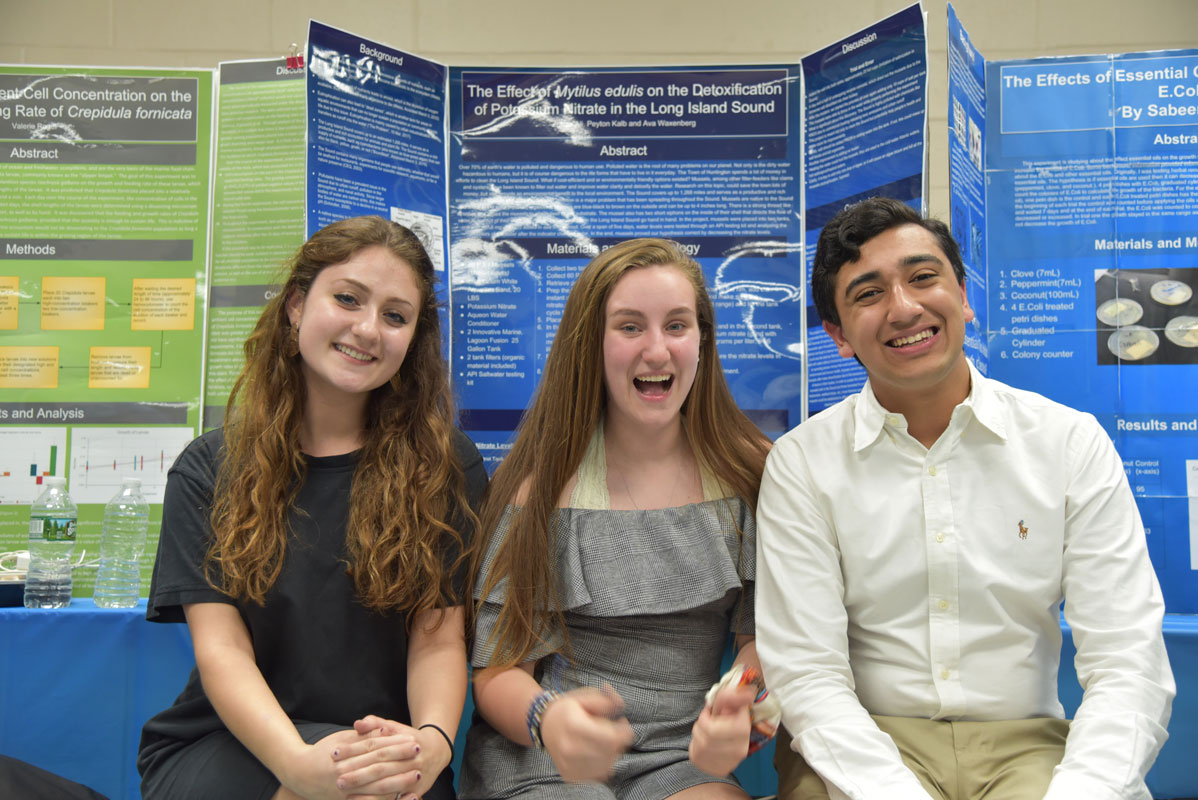The Huntington High School science research project team consisting of juniors Zubair Ali, Peyton Kalb and Ava Waxenberg won second place honors in the New York State Science and Engineering Fair’s JV division for their project on Long Island Sound pollution and its effects.
“This experience in the New York State Science and Engineering Fair was truly a rewarding one,” Mr. Ali said. “At the competition, we were packed in a gymnasium at Bethpage Middle School and presented to three sets of judges. It was super fun and the three of us had a great time.”
The three Huntington science research program students finished second in the Environmental Sciences category. They picked up their awards late last week during a ceremony at Jericho High School. About 500 projects vied in the overall competition.
“Over 70 percent of Earth’s water is polluted and dangerous to human use,” according to an abstract of the project. “Polluted water is the root of many problems on our planet. Not only is the dirty water hazardous to humans, but it is of course dangerous to the life forms that have to live in it every day. The Town of Huntington spends a lot of money in efforts to clean the Long Island Sound. What if cost-efficient and or environmentally friendly options existed? Mussels, among other filter-feeders like clams and oysters, have been known to filter out water and improve water clarity and detoxify the water. Research on this topic, could save the town lots of money, but also provide an environmental benefit to the local environment.”
The project involved putting mussels in a pair of holding tanks, including one with 387.6 mg of KNO3 added in and one without. “Over a span of five days, water levels were tested through an API testing kit and analyzing the colors of the water after the indicator changes color,” according to the project abstract. “In the end, mussels proved our hypothesis correct by decreasing the nitrate levels.”
About 100 students spread across grades 9-12 participated in Huntington High School’s science program this year. The students worked with teachers Lori Kenny, Dame Forbes, Matthew Liguori and Deborah Beck.
“We really felt our project could potentially have a huge impact on our local environment considering how much pollution is in the LI Sound,” Mr. Ali said. “With this huge buildup, we cannot let artificial substances clean more artificial substances. We need an ecological friendly solution, hence our project utilizing mussels as our cleaning agent.”
The Huntington trio worked hard on the project over the span of many months. The final result and their findings are impressive and worthy of discussion by environmental planners.
Untold hours of research went into the project. “The Sound covers up to 1,268 miles and serves as a productive and rich ecosystem for animals and plant life,” according to the project abstract. “Nitrogen pollution is a major problem that has been spreading throughout the Sound. Mussels are native to the Sound and are one of the most important organisms. Mussels are blue-black to brown on the outside and can be up to 4 inches long. There is a strong thread like structure that allows the mussels to attach itself to any substrate. The mussel also has two short siphons on the inside of their shell that directs the flow of water in and out of their shell. Mussels and water pollution in the Long Island Sound go hand in hand.”


